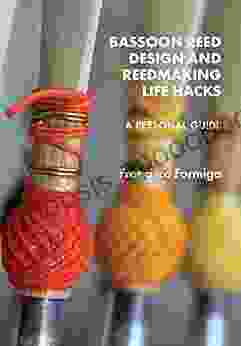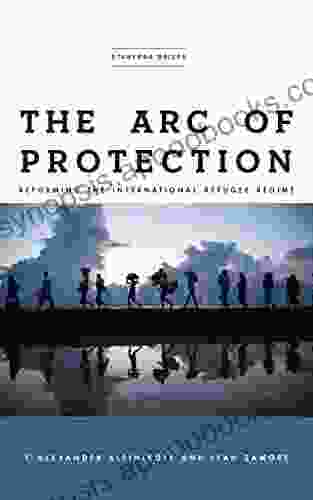Bassoon Reed Design and Reedmaking Life Hacks: The Ultimate Guide to Creating Perfect Bassoon Reeds

As a bassoonist, the quality of your reeds is paramount to your musical performance. A well-made reed will produce a rich, resonant sound, while a poorly made reed will hinder your playing and make it difficult to achieve the desired results.
4.8 out of 5
| Language | : | English |
| File size | : | 21487 KB |
| Text-to-Speech | : | Enabled |
| Enhanced typesetting | : | Enabled |
| Word Wise | : | Enabled |
| Print length | : | 94 pages |
| Screen Reader | : | Supported |
In this comprehensive guide, we will delve into the art of bassoon reed design and provide you with a wealth of tips and tricks to help you create perfect reeds every time. We will cover everything from choosing the right materials to advanced design techniques and troubleshooting common problems.
Chapter 1: Choosing the Right Materials
The first step in making a great bassoon reed is choosing the right materials. The two most important factors to consider are the cane and the thread.
Cane
Cane is the primary material used in the construction of bassoon reeds. It is a natural material that is harvested from the Arundo donax plant. The quality of the cane will have a significant impact on the sound of your reed.
When choosing cane, look for stalks that are straight, blemish-free, and have a consistent thickness. Avoid cane that is too soft or too hard, as this will make it difficult to shape and adjust the reed.
Thread
Thread is used to bind the cane together and to create the tip of the reed. The type of thread you use will also affect the sound of your reed.
There are two main types of thread used for bassoon reeds: linen and silk. Linen thread is strong and durable, but it can be difficult to work with. Silk thread is more delicate, but it is easier to manipulate and produces a more flexible reed.
Chapter 2: Reed Design
Once you have chosen the right materials, it is time to start designing your reed. The design of your reed will determine its playing characteristics, such as its pitch, volume, and response.
Shape
The shape of your reed will have a significant impact on its sound. There are many different reed shapes to choose from, each with its own unique characteristics.
Some of the most common reed shapes include:
- French shape: This is a traditional reed shape that is known for its rich, resonant sound.
- American shape: This reed shape is designed to produce a brighter, more focused sound.
- German shape: This reed shape is a hybrid of the French and American shapes, and it offers a balance of richness and brightness.
Thickness
The thickness of your reed will also affect its sound. A thicker reed will produce a darker, more mellow sound, while a thinner reed will produce a brighter, more articulate sound.
The thickness of your reed should be chosen based on your personal playing style and the type of music you are playing.
Tip
The tip of your reed is responsible for producing the sound. The shape and size of the tip will determine the pitch and response of your reed.
There are many different tip shapes to choose from, each with its own unique characteristics. Some of the most common tip shapes include:
- Round tip: This tip shape produces a warm, mellow sound.
- Square tip: This tip shape produces a brighter, more focused sound.
- Beveled tip: This tip shape is a hybrid of the round and square tips, and it offers a balance of warmth and brightness.
Chapter 3: Reedmaking Techniques
Once you have designed your reed, it is time to start making it. The reedmaking process is a delicate one, and it takes time and practice to develop the skills necessary to make a great reed.
Shaping the Cane
The first step in making a reed is to shape the cane. This can be done using a variety of tools, including a knife, a plane, and a scraper.
When shaping the cane, it is important to be patient and to take your time. The goal is to create a smooth, even surface that will produce a clear, resonant sound.
Binding the Cane
Once the cane has been shaped, it is time to bind it together. This is done using thread. The thread should be wrapped tightly around the cane, but not so tightly that it cuts into the cane.
There are many different ways to bind a reed. The most common method is to use a simple overhand knot.
Creating the Tip
The next step is to create the tip of the reed. This is done by cutting a small piece of cane and attaching it to the end of the reed.
The tip should be cut to the desired shape and size. The most common tip shape is a round tip.
Finishing the Reed
Once the tip has been created, the reed is finished. This involves scraping the reed to remove any excess material and to smooth out the surface.
The reed is now ready to be played.
Chapter 4: Troubleshooting Reed Problems
Even the most experienced reedmakers will encounter problems from time to time. Here are some of the most common reed problems and how to fix them:
- The reed is too hard. This can be caused by using cane that is too thick or by binding the cane too tightly. To fix this, try using thinner cane or binding the cane more loosely.
- The reed is too soft. This can be caused by using cane that is too thin or by binding the cane too loosely. To fix this, try using thicker cane or binding the cane more tightly.
- The reed is too bright. This can be caused by using a reed shape that is too thin or by creating a tip that is too small. To fix this, try using a thicker reed shape or creating a tip that is larger.
- The reed is too dark. This can be caused by using a reed shape that is too thick or by creating a tip that is too large. To fix this, try using a thinner reed shape or creating a tip that is smaller.
- The reed is not responding well. This can be caused by a variety of factors, including using cane that is not properly seasoned, using thread that is too thick, or creating a tip that is not the right shape or size. To fix this, try using well-seasoned cane, thinner thread, or a different tip shape or size.
Chapter 5: Bassoon Reed Life Hacks
In addition to the basic reedmaking techniques, there are a number of life hacks that can help you to make your reeds last longer and perform better.
- Use a reed case. A reed case will help to protect your reeds from damage and keep them moist.
- Store your reeds in the refrigerator. This will help to keep your reeds fresh and prevent them from drying out.
- Soak your reeds before playing. This will help to soften the cane and make it more responsive.
- Break in your reeds gradually. Do not play your reeds for too long at first. Gradually increase the amount of time you play them as they break in.
- Adjust your reeds regularly. As your reeds break in, you may need to adjust them to maintain their optimal playing condition.
Making great bassoon reeds is a challenging but rewarding task. By following the tips and techniques outlined in this guide, you can learn to make reeds that will help you to achieve your musical goals.
Remember, practice makes perfect. The more you make reeds, the better you will become at
4.8 out of 5
| Language | : | English |
| File size | : | 21487 KB |
| Text-to-Speech | : | Enabled |
| Enhanced typesetting | : | Enabled |
| Word Wise | : | Enabled |
| Print length | : | 94 pages |
| Screen Reader | : | Supported |
Do you want to contribute by writing guest posts on this blog?
Please contact us and send us a resume of previous articles that you have written.
 Book
Book Novel
Novel Page
Page Chapter
Chapter Text
Text Story
Story Genre
Genre Reader
Reader Library
Library Paperback
Paperback E-book
E-book Magazine
Magazine Newspaper
Newspaper Paragraph
Paragraph Sentence
Sentence Bookmark
Bookmark Shelf
Shelf Glossary
Glossary Bibliography
Bibliography Foreword
Foreword Preface
Preface Synopsis
Synopsis Annotation
Annotation Footnote
Footnote Manuscript
Manuscript Scroll
Scroll Codex
Codex Tome
Tome Bestseller
Bestseller Classics
Classics Library card
Library card Narrative
Narrative Biography
Biography Autobiography
Autobiography Memoir
Memoir Reference
Reference Encyclopedia
Encyclopedia Nancy Cunningham
Nancy Cunningham Maria Siopis
Maria Siopis Colin Dueck
Colin Dueck D D Cross
D D Cross John Mauk
John Mauk Hugh Cornwell
Hugh Cornwell Zack Parsons
Zack Parsons Richard Carlson
Richard Carlson Clay Schaub
Clay Schaub D N Meinster
D N Meinster Helen Fields
Helen Fields Sarah Noffke
Sarah Noffke Curt Vevang
Curt Vevang Daniel Goleman
Daniel Goleman Craig Speck
Craig Speck Craig Dilouie
Craig Dilouie Daisy Ashford
Daisy Ashford Daddy Wendell
Daddy Wendell Hugh Macdonald
Hugh Macdonald Robert W Maloy
Robert W Maloy
Light bulbAdvertise smarter! Our strategic ad space ensures maximum exposure. Reserve your spot today!

 Christopher WoodsImmerse Yourself in the Enchanting City of Love: 'A Season in Paris' by Nancy...
Christopher WoodsImmerse Yourself in the Enchanting City of Love: 'A Season in Paris' by Nancy...
 Eddie PowellThe Hidden Story of Richard Sorge: Unveiling the Enigmatic Life of a Master...
Eddie PowellThe Hidden Story of Richard Sorge: Unveiling the Enigmatic Life of a Master...
 Arthur Conan DoyleUnlocking Sustainable Growth in a Resource-Constrained World: A Comprehensive...
Arthur Conan DoyleUnlocking Sustainable Growth in a Resource-Constrained World: A Comprehensive...
 Elliott CarterThe Oxford Handbook of the Constitution: The Essential Guide to the U.S....
Elliott CarterThe Oxford Handbook of the Constitution: The Essential Guide to the U.S.... Herman MitchellFollow ·2.2k
Herman MitchellFollow ·2.2k Richard WrightFollow ·7.5k
Richard WrightFollow ·7.5k Clay PowellFollow ·7.8k
Clay PowellFollow ·7.8k Sidney CoxFollow ·2.8k
Sidney CoxFollow ·2.8k Blake BellFollow ·8.6k
Blake BellFollow ·8.6k Adrian WardFollow ·19k
Adrian WardFollow ·19k Chance FosterFollow ·6.2k
Chance FosterFollow ·6.2k Trevor BellFollow ·6.7k
Trevor BellFollow ·6.7k

 Cooper Bell
Cooper BellKids Rule Box Office Hits for the Elementary Player
Empowering Young Performers:...

 Gabriel Blair
Gabriel BlairUnraveling the Enigma: Political Alienation and Its...
In the labyrinthine tapestry of human...

 Anthony Burgess
Anthony BurgessBe a Great Singer: Unleash Your Musical Talent with...
Do you dream of singing with...

 Heath Powell
Heath PowellDive into a Musical Masterpiece: "10 for 10 Sheet Music...
An Enchanting Journey Through Broadway...

 Guy Powell
Guy PowellUniversal Rights, Systemic Violations, and Cultural...
The notion of universal human rights is a...
4.8 out of 5
| Language | : | English |
| File size | : | 21487 KB |
| Text-to-Speech | : | Enabled |
| Enhanced typesetting | : | Enabled |
| Word Wise | : | Enabled |
| Print length | : | 94 pages |
| Screen Reader | : | Supported |






